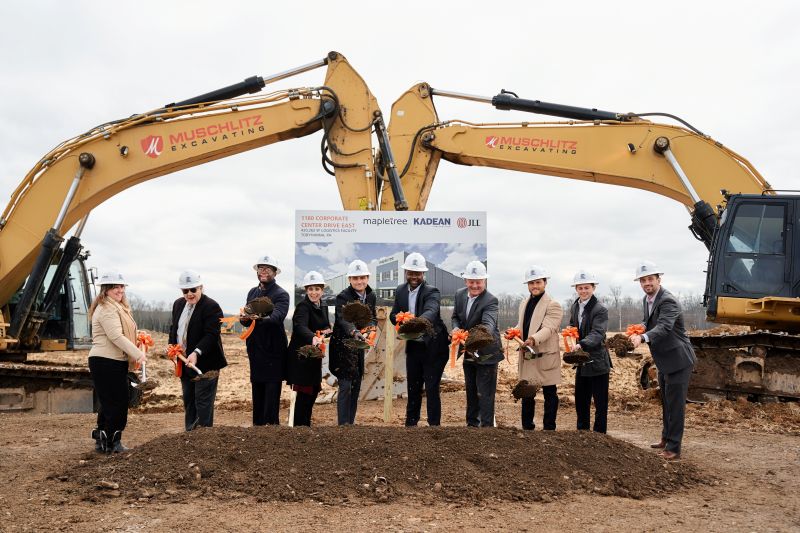Kenya Partners with Korea’s KIND to Accelerate Smart and Sustainable Infrastructure Development – TechAfrica News

Report on Kenya-Korea Partnership for Sustainable Infrastructure Development
1.0 Introduction: Fostering Global Partnerships for Sustainable Goals
A strategic meeting was held between Eng. John Kipchumba Tanui, Principal Secretary for the State Department of ICT and Digital Economy of Kenya, and Ms. Ji Hye Choi, Managing Director of the Korea Overseas Infrastructure & Urban Development Corporation (KIND) Africa Office. The discussion centered on establishing a partnership to advance Kenya’s national infrastructure. This collaboration directly supports Sustainable Development Goal 17 (Partnerships for the Goals) by leveraging international expertise to achieve sustainable development objectives.
The partnership aims to align KIND’s proficiency in Public-Private Partnerships (PPPs) with Kenya’s National Infrastructure Fund (NIF), a framework designed to finance critical projects sustainably without increasing public debt.
2.0 Core Objectives and Alignment with Sustainable Development Goals (SDGs)
The primary objectives of the collaboration are intrinsically linked to the global 2030 Agenda for Sustainable Development.
- Develop Resilient Infrastructure: To build quality, reliable, sustainable, and resilient infrastructure to support economic development and human well-being, directly addressing SDG 9 (Industry, Innovation, and Infrastructure).
- Promote Inclusive and Sustainable Urbanization: To facilitate the development of smart and modern cities, enhancing inclusive and sustainable urban planning and management in line with SDG 11 (Sustainable Cities and Communities).
- Foster Sustainable Economic Growth: To create employment opportunities and attract investment through infrastructure projects, contributing to SDG 8 (Decent Work and Economic Growth).
- Ensure Access to Essential Services: To advance energy and water projects that support industry, agriculture, and communities, thereby supporting SDG 6 (Clean Water and Sanitation) and SDG 7 (Affordable and Clean Energy).
3.0 Key Areas of Cooperation and Specific SDG Impact
Several priority sectors were identified for joint development, each contributing to specific SDGs:
- Smart and Sustainable Cities: This initiative focuses on creating inclusive, safe, resilient, and sustainable urban environments, which is the core target of SDG 11.
- Sustainable Industrial Parks: The development of the North Rift Green Industrial Park will promote inclusive and sustainable industrialization, directly contributing to SDG 9. It also fosters responsible production patterns, aligning with SDG 12 (Responsible Consumption and Production).
- Clean Energy and Water Infrastructure: Projects in these sectors are critical for ensuring universal access to affordable, reliable, and modern energy services (SDG 7) and the availability and sustainable management of water and sanitation for all (SDG 6). These developments also support food security by bolstering agriculture, a key component of SDG 2 (Zero Hunger).
- Public-Private Partnership (PPP) Frameworks: The implementation of PPPs serves as a mechanism to achieve the goals outlined in SDG 17, mobilizing financial resources and technical expertise from the private sector to enhance public infrastructure.
4.0 Conclusion: A Commitment to a Sustainable and Prosperous Future
The partnership between Kenya and KIND represents a forward-looking strategy to accelerate national development in alignment with the Sustainable Development Goals. By focusing on green, resilient, and connected infrastructure, the collaboration is poised to stimulate inclusive economic growth, enhance environmental sustainability, and improve the quality of life for all Kenyan citizens. This initiative underscores a commitment to building a prosperous and sustainable future through innovative financing and international cooperation.
Analysis of SDGs, Targets, and Indicators
1. Which SDGs are addressed or connected to the issues highlighted in the article?
-
SDG 9: Industry, Innovation, and Infrastructure
The article’s central theme is the development of Kenya’s infrastructure, including transport, energy, and urban systems. It explicitly mentions creating “resilient, green, and connected infrastructure” and promoting “sustainable industrial parks,” which are core components of SDG 9.
-
SDG 17: Partnerships for the Goals
The entire article describes an international partnership between Kenya and the Korea Overseas Infrastructure & Urban Development Corporation (KIND). This collaboration focuses on mobilizing financial resources through Public-Private Partnerships (PPPs) and leveraging global expertise, directly aligning with the principles of SDG 17.
-
SDG 11: Sustainable Cities and Communities
The partnership aims to support the “development of smart and modern cities” and strengthen “urban systems.” This directly addresses the goal of making cities and human settlements inclusive, safe, resilient, and sustainable.
-
SDG 8: Decent Work and Economic Growth
A stated outcome of the collaboration is to “create more jobs, attract investment, and stimulate growth.” These objectives are fundamental to promoting sustained, inclusive, and sustainable economic growth and productive employment for all.
-
SDG 7: Affordable and Clean Energy
The article mentions plans to advance “energy infrastructure projects” and develop “green” infrastructure, such as the “North Rift Green Industrial Park.” This points to a commitment to modern and sustainable energy solutions.
-
SDG 6: Clean Water and Sanitation
The cooperation includes advancing “water infrastructure projects” to support both industry and agriculture, which is essential for the sustainable management of water resources.
2. What specific targets under those SDGs can be identified based on the article’s content?
-
SDG 9: Industry, Innovation, and Infrastructure
- Target 9.1: Develop quality, reliable, sustainable and resilient infrastructure. The article’s focus on transforming Kenya’s “transport, energy, and urban systems” to be “resilient, green, and connected” directly supports this target.
- Target 9.a: Facilitate sustainable and resilient infrastructure development in developing countries through enhanced financial, technological and technical support. The partnership with KIND to provide “valuable technical and financial collaboration” is a clear example of this target in action.
-
SDG 17: Partnerships for the Goals
- Target 17.3: Mobilize additional financial resources for developing countries from multiple sources. The creation of the “National Infrastructure Fund (NIF)” is a new framework designed specifically to “mobilize investment for infrastructure projects” from investors and partners.
- Target 17.17: Encourage and promote effective public, public-private and civil society partnerships. The discussions centered on using “Public-Private Partnerships (PPPs)” as a key mechanism for infrastructure development.
-
SDG 11: Sustainable Cities and Communities
- Target 11.a: Support positive economic, social and environmental links between urban, peri-urban and rural areas by strengthening national and regional development planning. The plan to develop “smart and modern cities” reflects an effort to improve urban planning and development.
-
SDG 8: Decent Work and Economic Growth
- Target 8.3: Promote development-oriented policies that support productive activities, decent job creation, entrepreneurship, creativity and innovation. The article explicitly states that the partnership aims to “create more jobs” and “stimulate growth.”
3. Are there any indicators mentioned or implied in the article that can be used to measure progress towards the identified targets?
-
For SDG 9:
The article implies progress can be measured by the successful implementation and development of key infrastructure projects. An implied indicator is the total investment in infrastructure projects mobilized through the NIF and partnerships like the one with KIND.
-
For SDG 17:
The article implies indicators related to the success of the partnership. This includes the amount of financial resources committed through Public-Private Partnerships (PPPs) and the number of strategic projects co-developed with international partners like KIND.
-
For SDG 8:
The article directly points to job creation as a key outcome. Therefore, a clear implied indicator is the number of new jobs created as a result of the infrastructure projects and the establishment of new industrial parks.
-
For SDG 11:
Progress towards developing “smart and modern cities” can be measured. An implied indicator would be the number of cities with implemented urban development and modernization plans resulting from this collaboration.
4. Table of SDGs, Targets, and Indicators
| SDGs | Targets | Indicators (Implied from the article) |
|---|---|---|
| SDG 9: Industry, Innovation, and Infrastructure | 9.1: Develop quality, reliable, sustainable and resilient infrastructure. 9.a: Facilitate sustainable infrastructure development through enhanced financial and technical support. |
Total investment in infrastructure projects (transport, energy, urban systems); Number of sustainable industrial parks established (e.g., North Rift Green Industrial Park). |
| SDG 17: Partnerships for the Goals | 17.3: Mobilize additional financial resources from multiple sources. 17.17: Encourage and promote effective public-private partnerships. |
Amount of financial resources mobilized through the National Infrastructure Fund (NIF); Number and value of Public-Private Partnership (PPP) projects initiated. |
| SDG 11: Sustainable Cities and Communities | 11.a: Support positive economic, social and environmental links by strengthening national and regional development planning. | Number of cities with implemented “smart and modern” urban development plans. |
| SDG 8: Decent Work and Economic Growth | 8.3: Promote development-oriented policies that support decent job creation. | Number of new jobs created from infrastructure projects; Rate of investment attracted to the country. |
| SDG 7: Affordable and Clean Energy | 7.a: Enhance international cooperation to facilitate access to clean energy technology and promote investment in energy infrastructure. | Investment in green energy infrastructure projects. |
| SDG 6: Clean Water and Sanitation | 6.5: Implement integrated water resources management. | Number of water infrastructure projects developed to support industry and agriculture. |
Source: techafricanews.com
What is Your Reaction?
 Like
0
Like
0
 Dislike
0
Dislike
0
 Love
0
Love
0
 Funny
0
Funny
0
 Angry
0
Angry
0
 Sad
0
Sad
0
 Wow
0
Wow
0




















































.jpg.webp?itok=0ZsAnae9#)

























